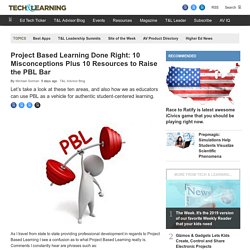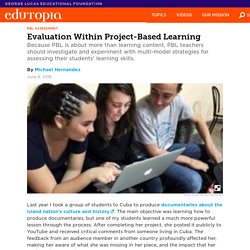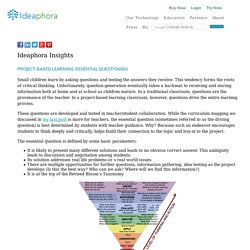

PBL Assessment: Real World and Real Stakes. I want to paint a scene that I’m sure is familiar to all of you.

Four judges sit casually on a couch, pen and paper in hand, listening discernibly to a speaker who pitches his idea for the latest breakthrough product. On this episode, a humble farmer from Arcadia, Florida shares his idea to lower costs associated with tree irrigation. His ‘Tree-Pee,’ a simple and portable irrigation system uses just 800 gallons of water (as opposed to 25,000 gallons typically used) to cultivate trees. Surprisingly, it also yields a 30 percent increase in growth. His product is judged by real-world experts and solves a real-world problem. On the other side of the country, a similar story unfolds.
Enter the Mojave Desert, a barren landscape apart from the sparse vegetation, and a humble group of ninth graders from High Tech High in San Diego. How to Use Project Based Learning in Your Classroom: 10 Resources. As I travel from state to state providing professional development in regards to Project Based Learning I see a confusion as to what Project Based Learning really is.

Comments I constantly hear are phrases such as: I already do PBL by incorporating a project at the end of the unit for learning.I tried PBL and I just did not have time to cover the standards.The problem with PBL is that projects cannot teach the standards.My students just cannot get engaged in PBL.I don’t think I can replace traditional teaching with PBLPBL Projects last too long.I cannot design cross-curricular projects because I only teach one subject.I cannot fill my year with PBLOur school does not have the technology to support PBLPBL does not provide the rigor students need in order to be college/career ready.
These are all misconceptions in the area of Project Based Learning. Let’s take a look at these ten areas, and also how we as educators can use PBL as a vehicle for authentic student-centered learning. Project-based Learning Blog Posts. Seven Myths Keeping Teachers from Implementing Creative Projects. Project Based Learning with Tynker. Adriene Guiriba is a third-grade teacher at Walter Hays Elementary School in Palo Alto.

She has been using Tynker since December 2012 with her 3rd grade class of 23 students. To date they have created over 600 projects using Tynker. Project Based Learning (PBL) is perhaps one of the simplest and most effective methods of increasing engagement in the classroom. 13 Brilliant Outcomes Of Project-Based Learning - 13 Brilliant Outcomes Of Project-Based Learning by Terry Heick Project-based learning isn’t a ‘trend’ any more than mobile devices are a trend.

Project-based Learning Resources for Teachers v... Edutopia. Techlearning. Evaluation Within Project-Based Learning. No test, grade, or teacher evaluation could have come close to helping her learn that deeply, and it made clear to me how important it is for teachers to reexamine why and how we grade our students if we truly care about their success.

As collaboration and project-based learning become preeminent ways of teaching and learning, many teachers struggle with how to evaluate these types of lessons. Traditional methods of evaluation, which have many flaws on their own, are not well-suited for interdisciplinary, multi-modal learning. Teachers need ideas for encouraging students, providing meaningful feedback, and setting students up for success. 15 Ideas to Ensure That Project Based Learning is Grounded in Content and Standards. You might know that I am a big proponent of PBL.

I believe that as we work on helping students understand the content standards, PBL provides teachers with the “how”. I do hope you enjoy this content driven article. What the Heck Is Project-Based Learning? You know the hardest thing about teaching with project-based learning?

Explaining it to someone. It seems to me that whenever I asked someone the definition of PBL, the description was always so complicated that my eyes would begin to glaze over immediately. So to help you in your own musings, I've devised an elevator speech to help you clearly see what's it all about. PBL: The Elevator Speech An elevator speech is a brief, one- or two-sentence response you could give someone in the amount of time it takes to go from the first floor to the second floor in an apartment building. Focus 2 Achieve - A Quick Guide To Successful Cyberspace Inquiry In The Classroom. So, before you're handed another copy/pasted definition of NOT WHAT IT'S SUPPOSED TO BE, teach them.

You must. Their future depends on it. Thus, my teacher brethren, this post is precisely about how to turn your students into successful Cyber Heroes capable of Cyberspace Inquiry. Your spaceship's arrived and you've been upgraded to first class. Hop in. Deal With The Real Let's be real. A few ideas... Chemistry is often abstract, so when life relevant topics come up, I jump at the chance to have students investigate the geeky side of things. Focus 2 Achieve - How To Transform Groupwork Into Collaboration. African wild dogs are fascinating hunters.

They hunt in packs of 6 to 20 animals. They often hunt prey that's bigger and faster than they are. Project-Based Learning: Essential Questioning. Small children learn by asking questions and testing the answers they receive.

This tendency forms the roots of critical thinking. Unfortunately, question-generation eventually takes a backseat to receiving and storing information both at home and at school as children mature. In a traditional classroom, questions are the provenance of the teacher. In a project-based learning classroom, however, questions drive the entire learning process. 8 Basic Steps Of Project-Based Learning To Get You Started - TeachThought PD. 8 Basic Steps Of Project-Based Learning To Get You Started by Drew Perkins, Director of TeachThought PD Grow with >> TeachThought PD PBL Workshops The process of designing and implementing project-based learning can be fairly complex. How Do I Differentiate Through Project-Based Learning? - How Do I Differentiate Through Project-Based Learning? By John McCarthy, TeachThought PD Workshop Facilitator Want to bring John McCarthy to your school for a PBL or Differentiation Workshop?
Contact Us>> “How do I differentiate through PBL?” Project Based Learning Resources - Raccolte. How to Improve Students Collaboration Skills – Project Pals. By Miriam Bogler 9/13/2016 Schools are adopting project-based learning in growing numbers. Although it may seem like a trend, it really stems from a development in pedagogical thinking over the past fifty years that advocated a shift away from teachers imparting knowledge to relatively passive students, to learners actively participating in the co-construction of knowledge.
Being a complete departure from traditional ways of teaching, implementation is difficult for multiple reasons, the most difficult of which have to do with teachers and students adapting to this new type of learning. Introducing: Educational Projects By David Thornburg — Polar3D. Background Sea shells are amazing objects to explore. Young children enjoy finding them, exploring their colors and shapes. They even hold large ones to their ears to “hear the ocean.” This project explores the spiral shape of many shells, with special focus on shapes similar to that of the chambered nautilus― a cephalopod whose shell is an equiangular spiral. 17 Teacher Tech Tools for High Quality Project-Based Learning - Getting Smart by Guest Author - Buck Institute for Education, Project-based learning, tech tools.
Bob Lenz and Sally Kingston Steven Covey says, “The main thing is to keep the main thing the main thing.” That’s what we say about Project Based Learning: make projects the main thing. Don’t fall into the trap of using a little PBL here and there. Students who engage regularly in well-designed projects retain knowledge better, learn more deeply with understanding, and develop skills to be successful in college, career and life. We have seen firsthand the transformation that happens for students, teachers, and communities when teachers keep PBL the main thing. Too often, projects are not the main thing because teachers need the time and support to make shifts in their practice from more traditional approaches. How can teachers make projects the main thing in their classrooms? Gold Standard PBL Teaching Practices. Digital Portfolios and Blogs: Use Authentic Technology, Not Technology Made for School - Cooper on Curriculum.
Why We Changed Our Model of the “8 Essential Elements of PBL” 3 Elements of Deeper Project-Based Learning. 5 Characteristics Of Project-Based Learning That Works - A PBL Project is Like the Hero’s Journey. I’ve been meaning to write this post after hearing an idea at PBL World 2015 in the keynote by Ramsey Musallam, an amazing speaker and high school chemistry teacher. Now that PBL World 2016 is almost upon us, I thought I’d better get this done so I can be ready to blog about this year’s events and ideas.
Ramsey likened the learning cycle that happens in PBL to the classic “hero’s journey” first explained by mythologist Joseph Campbell in The Hero with a Thousand Faces (1949). How to use Google tools in Project-Based Learning. Tools for Differentiating Instruction in PBL. In the first few years of my career, I never understood the nuances of differentiated instruction. When asked by administrators, teachers, or parents, I would confidently proclaim that I was indeed differentiating content, process, and products for all my students, and doing it well. Reality however, was different.
Making Room for Children's Ideas Through PBL. The case for project-based learning. Going Gradeless: Student Self-Assessment in PBL. I like reading professional material. I would posit that most teachers do. Professional reading (OK, all reading, really) allows our thoughts to constantly shift, transform, and travel to currently uncharted mental territory. If we are lucky, we encounter a watershed idea or concept that shatters our thoughts and understanding to such an extent that it requires a complete rebuilding of our philosophy. I was provided such a moment when I read Mark Barnes’ Role Reversal: Achieving Uncommonly Excellent Results in a Student-Centered Classroom in the spring of 2015.
Mr. My Goal It was my intention to simultaneously promote mastery learning as well as increase students' ability to metacognitively assess their work against a given set of standards. Remove grades from the daily equation. My Plan I knew that I needed to maintain accountability to various stakeholders in this process -- the students, their families, and the administration. The Results. Making Room for Children's Ideas Through PBL. 3 PBL Practices to Empower Students. Edutopia. Project-based Learning: What It Is, and How It Benefits Students. As a foreign language teacher, I need to assess my students in a variety of ways on a regular basis.
As we all know, not every person learns the same way or has the same interests. In terms of assessment, some students can learn the material really well, but when a traditional test is given, their information and knowledge somehow disappears. When this first happened in my classes, I began looking more at ways to assess my students–but to provide assessments which led to more authentic and personalized work. I wanted to provide an equal opportunity for students to achieve success in showing what they know (and can do) with the information that they have learned.
Going Deeper with Hands-On Tech in Education. What the Heck Is Project-Based Learning? Project Based Learning: Explained. Project-based learning moves into classrooms. A Project-Based Learning Cheat Sheet For Authentic Learning. How to Reinvent Project Based Learning to Be More Meaningful. What It Takes to Become an All Project-Based School. Can Project-Based Learning Close Gaps in Science Education? Using Google Tools in Project-Based Learning Infographic. How to Create the Learning Community Vital to Project-Based Learning’s Success. Integrating Technology with Project Based Learning: Four Indicators to Blend the Learning. What Project-Based Learning Is — and What It Isn’t. Integrating Technology with Project Based Learning: Four Indicators to Blend the Learning. PBL Pilot: 4 Strategies to Implement and Spread PBL in Your School. Watch and Learn: Observing the PBL Classroom. "Fitting In" PBL.
What Project-Based Learning Is — and What It Isn’t. 5 PBL Best Practices for Redefining the Teacher's Role. Embracing Messy Learning.